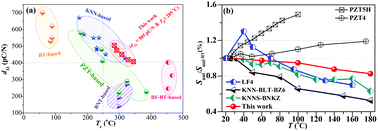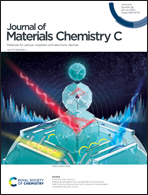Advances in the modification of the contradictory relationship between piezoelectricity and Curie temperature: simultaneous realization of large piezoelectricity and high Curie temperature in potassium sodium niobate-based ferroelectrics†
Abstract
For potassium sodium niobate (KNN)-based ferroelectrics, a critical contradictory relationship exists where higher piezoelectricity is often achieved at the cost of their Curie temperature, and this severely restricts the practical applications of these ferroelectrics. How to resolve this contradiction is one of the urgent concerns in high-temperature piezoelectric applications. Herein, a new material system, 0.965K0.54Na0.46Nb1−xSbxO3-0.03Bi0.5Na0.5ZrO3-0.005BiFeO3 (KNNSx-BNZ-BF, 0 ≤ x ≤ 0.03), was obtained by compositional selection. A significant progress with respect to the simultaneous realization of a large d33 (∼505 pC N−1) and a high TC (∼285 °C) was achieved in this ferroelectric, which are superior to those of the KNN-based ferroelectrics reported to date. In addition, good temperature-independent strain properties were attained for this material due to its high TC values. Therefore, this KNN-based system may promote the practical application of lead-free materials in high-temperature fields.



 Please wait while we load your content...
Please wait while we load your content...